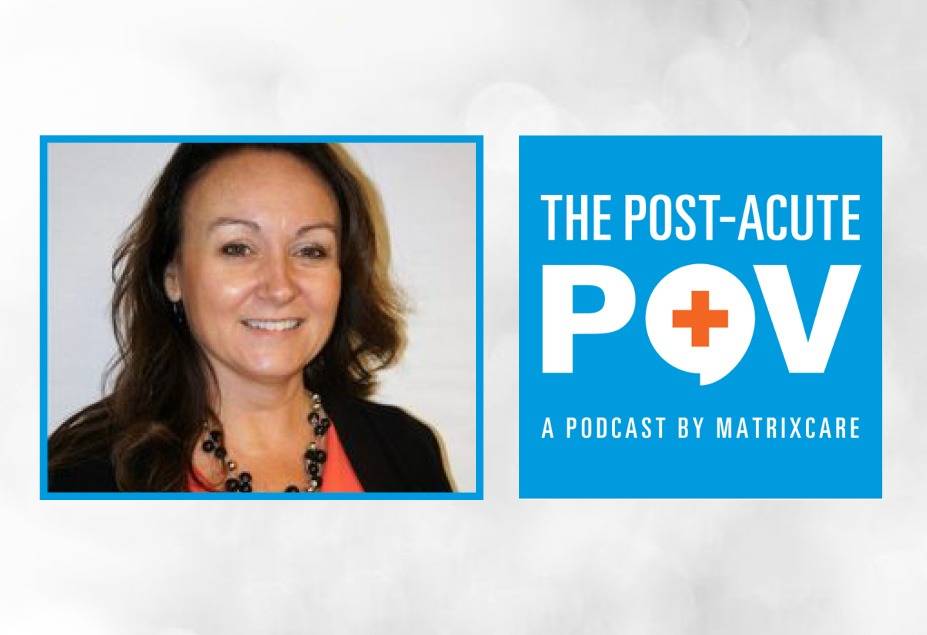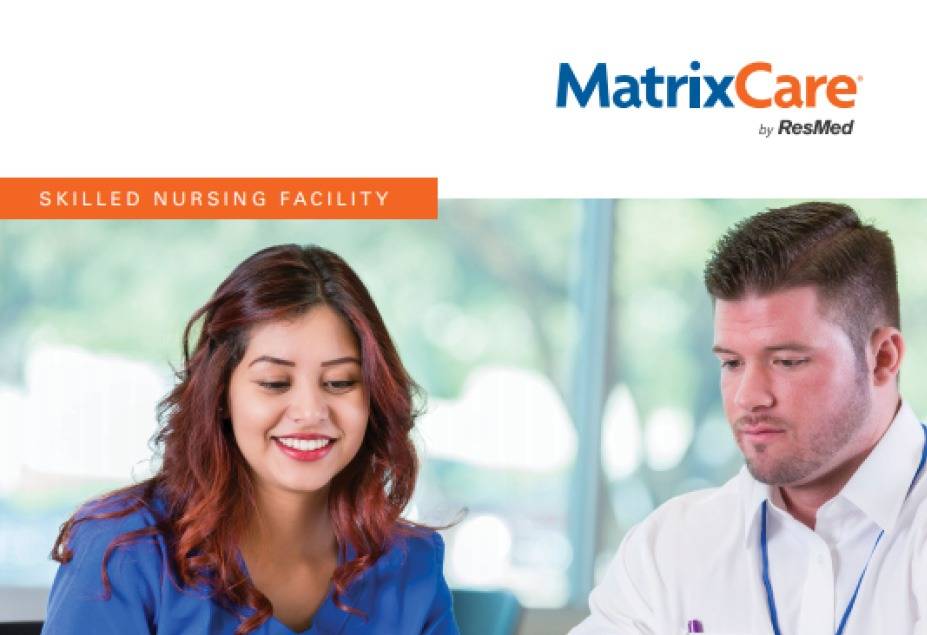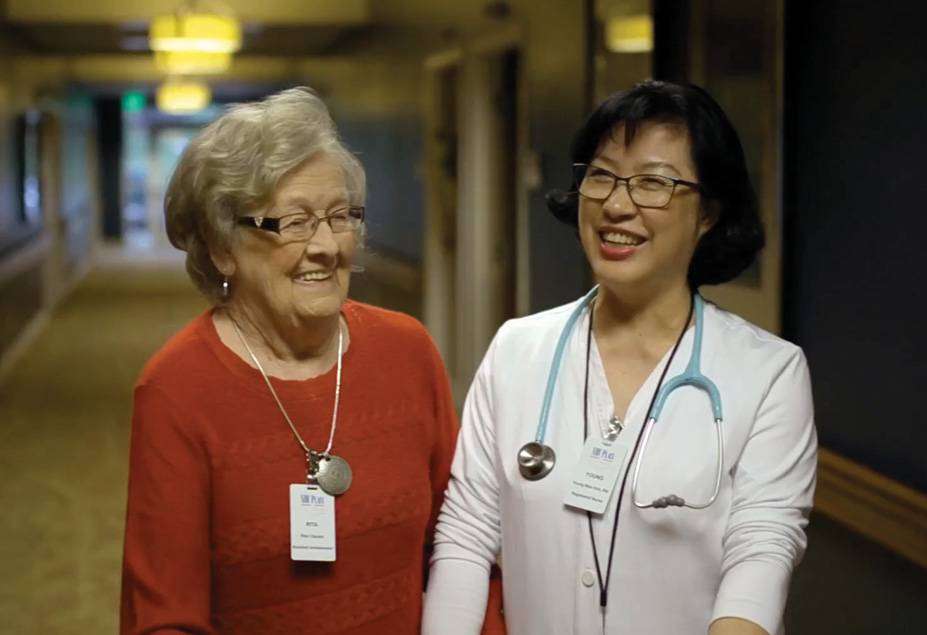In this episode of the Post-Acute POV, our host, Kevin Whitehurst, SVP of skilled nursing solutions, sits down with Amy Ostrem, VP of skilled nursing solution strategy, to discuss how your skilled nursing facility can benefit from interoperability.
Amy provides interesting and easy-to-understand insight into the value interoperability can bring to your organization. These benefits include an enhanced relationship with referral partners, better overall analysis of outcomes, and a detailed view into trends and performance indicators based on discreet clinical data. Listen to this exciting conversation to learn more.
Topics discussed during today’s episode:
- [01:07 – 02:05]: Amy’s origin story, her career before MatrixCare.
- [02:41 – 03:48]: The upfront benefits of interoperability including an enhanced relationship with your referral partners and the ability to seamlessly send and receive data.
- [04:19 – 06:00]: How skilled nursing facilities can benefit from interoperability around daily operations post-admission like better overall analysis of outcomes and a detailed view into the trends and performance indicators based on discreet clinical data
- [06:31 – 8:54]: Amy lists specific value gains from interoperability for some of the various roles in care centers today. These include vital sign integration, therapy notes, and evaluations.
- [9:45 – 11:01]: The importance of staying up to date on your facility’s integrations and regularly advancing these integrations for optimized interoperability.
Resources
- Find out more about our commitment to interoperability: https://matrixcare.com/interoperability/
- Listen to more episodes of the Post-Acute POV
Transcript
Speaker 1
Hi, and welcome to The Post-Acute Point of View, our discussion hub for healthcare technology and the out of hospital space. Here, we talk about the latest news and views on trends and innovation that can impact the way post-acute care providers work. And we take a look at how technology can make a difference in today’s changing healthcare landscape in both home-based and facility-based care organizations and the lives of the people they serve. Today we hear from Kevin Whitehurst, Senior Vice-President of Skilled Nursing Solutions for MatrixCare and his special guest. Let’s dive in.
Kevin Whitehurst
Hi, this is Kevin Keith Whitehurst, Senior Vice-President Skilled Nursing Solutions at the MatrixCare. And I want to thank you all for joining us today. I’m here today with Amy Ostrem, the Vice-President of Skilled Nursing Solution strategy for a discussion on ways interoperability can benefit skilled nursing facilities. Well, let’s go ahead and get started. Amy, so great to have you join us again. Interoperability is such a great topic. Can you just remind our listeners of your origin story?
Amy Ostrem
Hi Kevin. Absolutely. I originally came to MatrixCare from working in the industry, focused on a revenue cycle management and the billing office and MatrixCare allowed me to really open up my passion and influence the entire country in all areas of long-term care that electronic health record and technology influence. And after working for several years, focused on educating our customers and building value and quality from an R&D perspective. It became evident that my favorite part is working closer with our clients, with industry experts and being able to really influence the industry in a larger way. So I have a ton of passion for this industry, and a lot of it comes from caring for our seniors and all of you, the people who serve them. I’m really energized by the passion and care that comes from the industry where like with MatrixCare and myself, care runs deep.
Kevin Whitehurst
Oh, that’s wonderful. And MatrixCare is so proud to have you part of the leadership team. So regarding interoperability, we’re here to talk about vital ways interoperability can benefit skilled nursing facilities. Now I’m sure everyone can think about many more benefits now with technology and interoperability being such a focus during the COVID pandemic. I think of things such as cutting down on passing paper and decreasing physical persons in the care centers. Amy, can you start by talking about the benefits upfront in the referral process with interoperability?
Amy Ostrem
Oh, absolutely. I still witness of variety of different ways referral information is getting into electronic health records from hospitals. It’s important to know that integration during the referral process can give you an enhanced relationship with your referral sources. Referral sources really prefer the option to seamlessly send and receive data on residents. And having technology that allows this will set you apart from your competition. But that’s not the only benefit of interoperability during the referral and pre-admission process. You’ll also make daily tasks less tedious. So instead of managing stacks of paper, electronic documents will arrive in record time. Your electronic health record will easily categorize and organize the types of documents you’re receiving. And I also think of accessibility and efficiency since your full professional and interdisciplinary staff will have secure, efficient access to that critical health information during and after admission.
Kevin Whitehurst
That’s huge, Amy. That is so great to hear. Thank you so much for that explanation. I can definitely see how having those pre-admission and admission documents from the hospital easily accessible can benefit the full interdisciplinary team. Now you mentioned the efficiencies of this upfront as a resident is really in a pre-admit or a referral status, but can you speak to interoperability benefits for skilled nursing facilities around daily operations post admission?
Amy Ostre
Oh sure. So obviously post admission is when the hands-on care, the equipment and technology all must work together to provide improved outcomes and live up to quality measures and other key performance indicators. Interoperability plays a big hand in this efficiency. Documenting electronically and sending and receiving data electronically means several different things. So less effort searching through resident records, less time communicating with providers since there are standardized transactions being sent and received. So such as with e-prescribing. There’s decreased transcription errors and more immediate information. So again, back to that accessibility statement, since your team has secure access, based on their role to each resident’s chart, no matter their physical location. And then also increased accessibility and visibility can provide a resident centered care through more informed care plans, thorough documentation, a greater likelihood of approved claims and full reimbursements.
Amy Ostre
And at the next level of your entire organization, better overall analysis of outcomes, of trends and performance indicators based on that discreet and especially that discreet clinical data. So when you think about all the positives with interoperability and efficient operations, you can experience a time savings and a cost savings from a paper perspective. You’ll enjoy a favorable bottom line when improving the wellbeing of your employees as they spend more time with residents.
Kevin Whitehurst
Absolutely. I’m sure our providers out there can relate to all of those systems working together and the importance of the time savings and the cost savings. The importance of the wellbeing of the staff on the front lines caring for our seniors is more important than ever these days. Can we dive in just a little deeper into some of the specific productivity gains for some of the various roles in care centers today. Like where are some of the top value gains from an interoperability perspective?
Amy Ostre
Oh, great question. Let me focus on a few that are more common across the majority of care centers out there. So from a front end caregiver perspective and for our nursing assistants across the country, vital sign integration has become a welcome benefit and value add. So not only are these folks able to simplify their workflow, but accuracy and real time data feeding into the EHRs is a welcome change. Being able to instantly notify care staff, if a resident’s vital sign is out of range, such as a fever coming on helps to proactively begin to identify a change in condition. And then from an interdisciplinary perspective, therapy notes and evaluations have become such a hot topic. And with integration, therapy notes and evaluations can be brought into the system on a regular ongoing basis so that the full interdisciplinary team has access to those therapy notes.
Amy Ostrem
And really being able to provide this level of detail provides an increase in the value of fully informed providers and care staff while also providing a time-savings since all of this data is now at their fingertips and it’s not in disparate systems or something. And then from a cashflow perspective, as we all know cash is king and there’s one area that can guarantee a time savings of 80% and that’s the workflow and seamless integration all the way from a payer initiating cash or remittance to the creation of, and the distribution to the appropriate resident accounts and the charges.
Amy Ostrem
So more efficient processes like this bring value in keeping your cash flow and cash analysis current all the way to the general ledger, keeping resident accounts current so that you can spend time following up on your outliers and collections, and it brings your DSO or days sales outstanding statistics that you can be proud of. And not to mention, but when providers, care staff and operations professionals are fully informed working together and sharing data electronically residents and their families are more likely to be satisfied and really trust the care centers out there.
Kevin Whitehurs
That’s a great point on the improved relationships with the residents and their families and that trust factor. Goes such a long way when the families can see the use of technology being integrated throughout their loved one’s stay. Now whether it’s the med card with a laptop instead of a big binder on top, a nurse that gets stopped by a family with a quick question about the latest therapy. And she can say, “Oh, sure, let me look that up for you.” Or she can see the vital sign machine [inaudible 00:09:25] around throughout the day. This definitely gives a sense of additional investment and focus on positive outcomes in leveraging innovation to accomplish that. So Amy, as we wrap this up, do you have any final thoughts around future preparedness and interoperability?
Amy Ostre
Yeah, sure thing. As part of your ongoing technology optimization reviews, be sure you’re taking advantage of opportunities that are available to enhance your business and maintain those strong connections to other providers. Stay up to date on integrations that your organization is using currently and be informed of what additional integrations are available. And beyond this, look to identify integrations that you know would solve problems and provide time savings and/or better outcomes and discuss these with your vendors that are out there. So if you feel your organization is on the side of using fewer integrations than typical, make a plan and set goals around advancing your integrations and interoperability. Ask your EHR vendor for their expertise on these integrations, have them help you look at the integrations that might be the biggest time savers that are the easiest to implement, and that contribute the most to better outcomes. And really by adopting interoperability technology now you can differentiate your care centers and be an industry leader as we all move toward an even more connected future.
Kevin Whitehurs
Well, this has been amazing. What a wealth of information. I want to thank all of you out there for joining us today. We had a great topic, how skilled nursing facilities can benefit from interoperability? And I also want to thank you again, Amy, for that wealth of information. It was just great to hear all of those benefits and the value of interoperability. So thank you so much for sharing.
Amy Ostrem
Yeah. My pleasure.
Speaker 1
That concludes the latest episode of The Post-Acute Point of View from MatrixCare. We have a lot of guests and topics coming up that you won’t want to miss. So be sure to subscribe. If you’ve enjoyed today’s podcast, and if you have a topic you’d like us to discuss, leave us a review. To learn more about MatrixCare and our solutions and services, visit matrixcare.com. You can also follow us on LinkedIn, Twitter, and Facebook. Thank you for listening. Be well. And we’ll see you next time.




